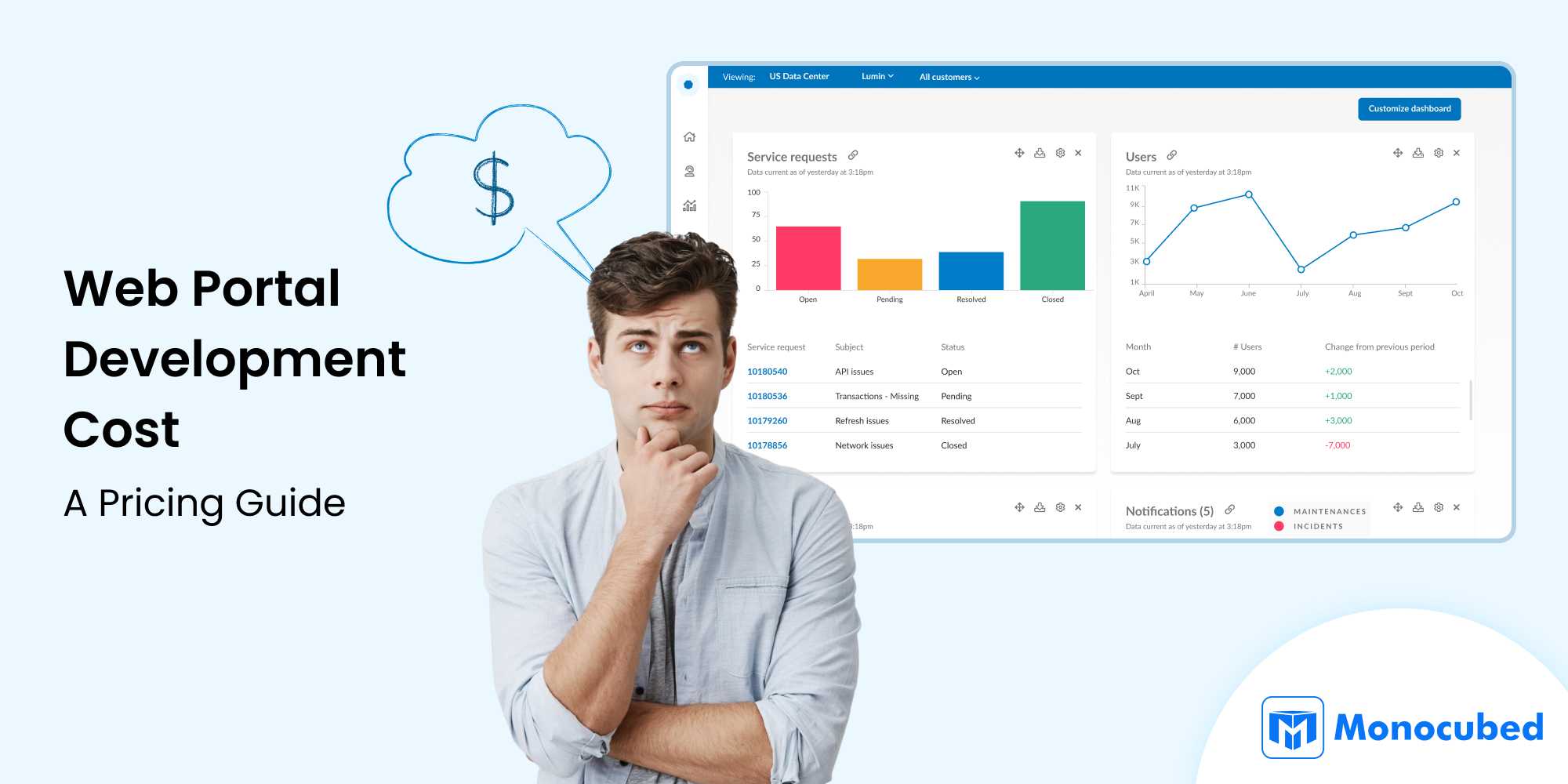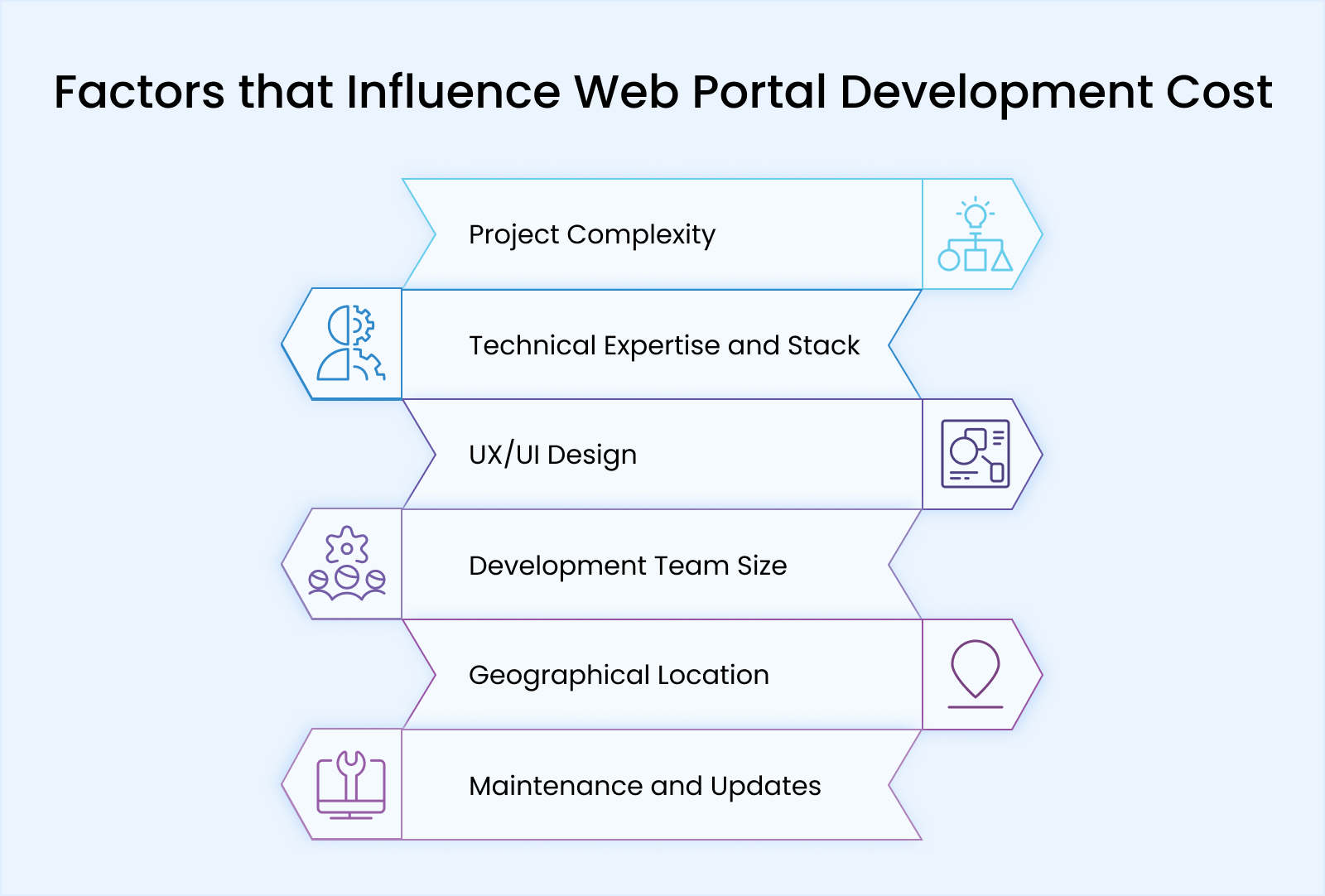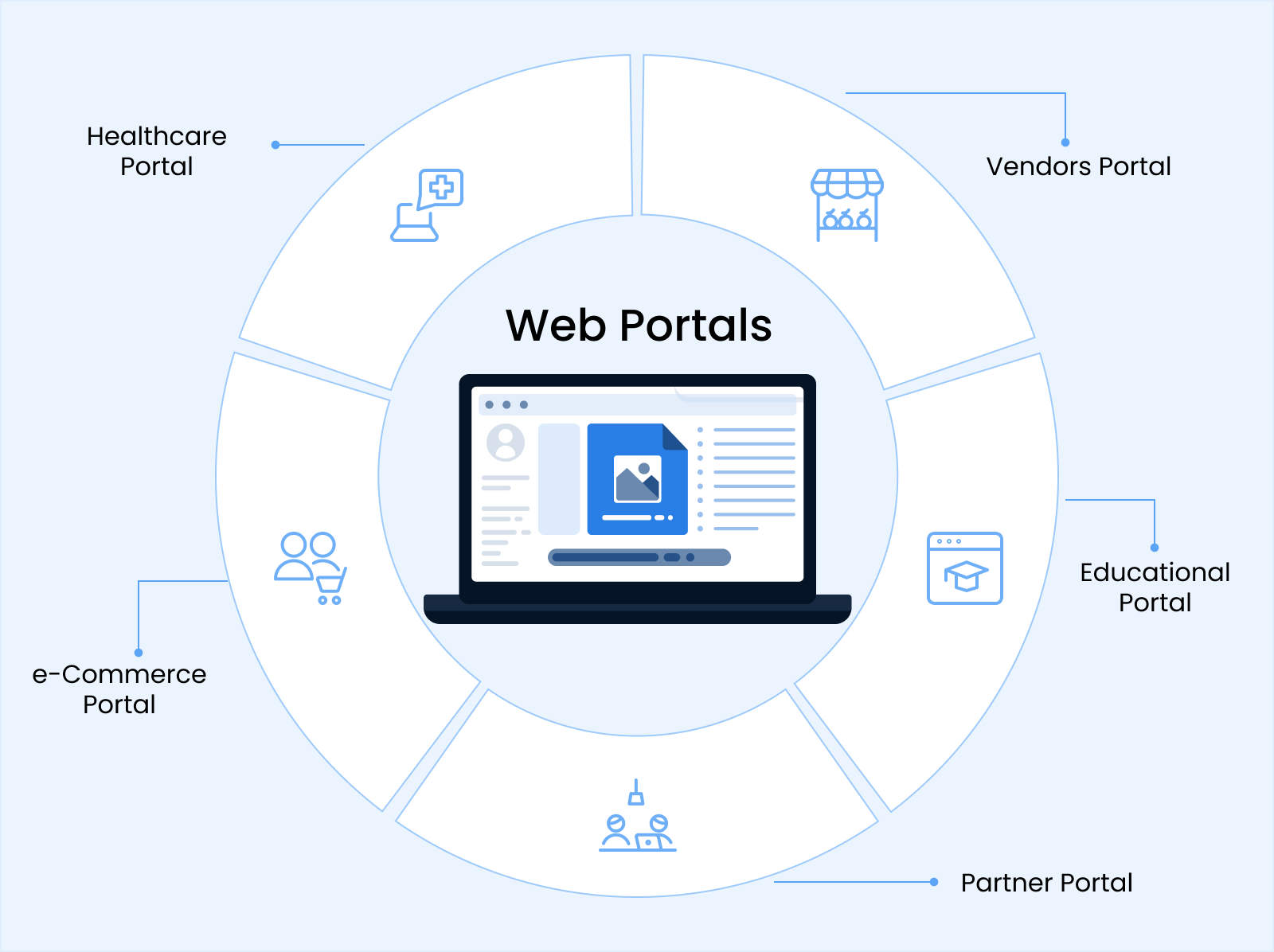Planning to develop a custom web portal for your business, but unsure how much you need to invest?
After building over 200 web portals for enterprises and startups, we’ve seen costs ranging between $10,000 and $500,000. Your exact web portal development cost depends on the portal’s complexity, required features, tech stack, and the location of your development team.
But what exactly drives these numbers — and how do you avoid overspending?
Before allocating your budget or choosing a web portal development company based on their quote, get a realistic breakdown of web portal development costs.
- Exact cost ranges for different portal types (customer, employee, vendor, enterprise)
- Hidden costs that can increase your budget by 25–40%
- Cost estimation frameworks used by top agencies
- What affects your final price — from AI to integrations
In this guide, you’ll understand everything that affects your budget and timeline:
By the end, you’ll have a clear budget framework, a precise understanding of what drives pricing variations, and be ready to request accurate quotes from development teams.
Want this information as a handy reference guide?
[Download Free Cost Guide PDF]
Table of Contents
8 Key Factors that Influence the Custom Web Portal Development Cost
Before obtaining quotes or planning your budget, it is essential to understand these eight factors, as each one can significantly impact your final investment.
Note: These figures are general estimates and may vary based on your specific project requirements.
-
Portal Complexity and features ( + specific cost impacts)
The complexity of your web portal directly influences both the development timeline and overall cost. As features become more advanced, they demand more profound technical expertise, longer build cycles, and greater resource allocation.
This is why project complexity becomes a key factor influencing the cost of web portal development effectively.
Cost estimates based on complexity level
Project Complexity Level Example Estimated Cost Key Features Development Time Simple Portals Basic corporate site or brochure portal Starts from $10,000 Basic informational site with minimal features 1-3 months Moderate Portals Customer support or employee portal Starts from $25000 Advanced functionalities, custom design, and integrations 4-6 months Complex Portals Enterprise-grade, multi-role platform Starts from $50000+ Enterprise-level features, custom backend, high security 6-12+ months -
Tech stack choices (+ cost comparisons)
Advanced tech stacks can significantly raise your web portal development cost—often by $10,000–$50,000 or more, depending on complexity.
Therefore, based on the complexity of your tech stack, the cost of developing your web portal varies.
Tech Stack Components Development Cost Best For Modern LAMP Linux, Apache, MySQL, PHP/Python Baseline cost MVPs, internal portals, CMS-driven sites JavaScript Stack (MEAN / MERN) MongoDB, Express.js, Angular or React, Node.js Adds +10–20% over LAMP Real-time dashboards, SaaS portals Cloud Services (Pay-as-You-Go) AWS, Google Cloud, Microsoft Azure Adds +20–35% over traditional stack Scalable enterprise portals from startups to enterprises Testing & QA Tools Selenium, Cypress, Jest, Postman, BrowserStack +5–10% of total budget Rapid prototypes and simple portals -
Technical expertise and experience of hired developers
The skill level of your development team creates a critical cost-time equation. If you hire senior web developers, their charges are higher hourly rates, they often deliver better value through faster execution and superior code quality.
For example:
Custom analytics dashboard development:
- Junior developer approach: Lower hourly rate but requires 4–5 weeks, potential rework, and close supervision.
- Senior developer approach: Higher hourly rate but completes in 1–2 weeks with better code quality, scalability, and fewer bug.s
Developer Experience Level Hourly Rate Range Project Efficiency Total Cost Impact Junior (1–3 years) Starts at $25 Longer timelines, potential rework It may cost more overall due to the extended timeline Mid-level (3–7 years) Starts at $30 Balanced speed and quality Optimal cost-efficiency for most projects Senior (7+ years) Starts at $45 Fast delivery, minimal rework Higher hourly rate but often lower total cost So while the hourly rate is higher, the total cost might be lower, and you’ll save time, reduce technical debt, and launch faster.
- Pro Tip: When evaluating costs based on hourly rates, consider the total development time, quality, and long-term value that a developer or web development team offers you.
-
UX/UI design and features
UX/UI design impacts your web portal development cost because it determines how users interact with your platform. Complex design requirements demand specialized skills, extended design cycles, and thorough testing.
What drives higher design costs?
- AI-powered personalizations require advanced user experience (UX) research and complex interface logic.
- Accessibility compliance demands specialized expertise and extensive testing.
- Mobile-first responsive design needs optimization across multiple devices and screen sizes.
It shows that the cost of UX/UI design depends on how users interact, how easily they find information, and how smoothly they complete actions.
Cost breakdown based on the design requirements
Design Requirement Description Estimated Cost AI-Powered Personalization Innovative layouts, chatbot UX, predictive user flows Starts at $4000 Mobile-First Responsive Design Optimized performance and usability across all devices Starts at $6000 Accessibility Compliance WCAG standards to make the portal usable for all Starts at $3000 Advanced Analytics Integration Behavioral tracking, user heatmaps, A/B testing setup Starts at $4500 Custom UX Research & Prototyping User journey mapping, wireframes, persona-based testing Starts at $3500 Microinteractions & UI Animations Smooth transitions, hover effects, and intuitive microfeedback for actions Starts at $3500 -
Development team structure
Your team composition directly impacts both the timeline and the total development cost. Simple portals may require 2-3 developers, while enterprise-grade projects necessitate 4 or more specialists working in parallel.
The bigger the team, the faster the work, but also the higher the cost of website portal development.
Development team cost breakdown
Team Role Key Responsibilities Average Rate (USD/hour) UX/UI Designer User research, wireframing, responsive design, accessibility compliance Starts at $30 Frontend Developer Building user-facing interface with React.js/Angular.js/Vue.js, performance tuning Starts at $35 Backend Developer Building APIs, data architecture, integrations, and authentication systems Starts at $35 QA Engineer Manual and automated testing, bug tracking, usability validation Starts at $30 Project Manager Planning, team coordination, timeline, and scope management Starts at $40 -
Geographical location of the development team (+ hourly rates)
Where your website development team is based can drastically impact how much you’ll pay, without always changing the quality of the output.
Web portal developers from North America, Western Europe, and Australia can charge premium rates due to higher living costs and demand. However, if you hire experienced web developers from countries like Latin America and South Asia, you’ve to pay sometimes 2x to 4x less for the same work.
Here’s a general breakdown of the hourly rates based on location:
Region Average Hourly Rate (USD) North America Starts at $75 Latin America Starts at $70 Eastern Europe Starts at $75 Western Europe Starts at $60 Asia Starts at $35 - Pro tip: Choose from top web portal development companies for experience, communication, and relevant web portal case studies, not just price.
-
Integration and third-party costs
Modern portals require extensive integrations, which directly affect web portal development costs through API licensing and development complexity.
Integration Type Development Cost Annual Licensing Complexity Impact CRM Integration (Salesforce, HubSpot) $5,000-$15,000 $1,200-$3,600 2-3 weeks development cost Payment Gateway (Stripe, PayPal) $3,000-$8,000 $0-$500 + transaction fees 1-2 weeks development cost ERP Systems (SAP, Oracle) $15,000-$50,000 $5,000-$25,000 4-8 weeks development cost AI/ML Services (AWS AI, Google Cloud) $10,000-$30,000 $2,400-$12,000 3-6 weeks development cost As modern web portals evolve into more innovative and AI-powered platforms, integrations are no longer optional for businesses. They are as crucial as security integrations.
Whether you’re syncing with CRMs, enabling secure payments, or embedding AI-powered capabilities, each integration adds a layer of cost that must be factored into your entire budget.
-
Maintenance and updates
Many businesses overlook post-launch costs, assuming the heavy lifting is done.
But without regular maintenance and timely updates, your portal can quickly become outdated and vulnerable to security threats. It can impact the performance of your web portal and lead to customer data leakage, resulting in increased costs in the long run.
Maintenance and update costs breakdown
Category What It Covers Estimated Cost Security AI threat detection, Advanced compliance monitoring (GDPR, CCPA), and Zero-trust security updates $500–$1,200/month Performance Cloud hosting, API integration & maintenance, and database performance optimization $400–$1,000/month AI Enhancements Smart features, predictive UX, automated patching $1,000–$3,000/quarter Testing and Backup Penetration tests, intelligent backups $3,000–$10,000 Current trend: Organizations utilizing AI-powered maintenance and cloud-native architectures can reduce total maintenance costs by 30-50% while enhancing security and performance.
A larger team accelerates delivery and spreads the workload, making it ideal for tight deadlines. However, it also means higher coordination and management overhead, as well as a higher cost per sprint. Choose the team based on the complexity of your project, not your budget.
Find Out How Much Your Web Portal Project Costs
Monocubed’s web portal experts provide you with detailed cost breakdowns based on your project’s needs, technical requirements, feature list, and timeline.
These key factors help you determine the amount of investment needed for future web portal development. Moreover, you can make more informed decisions, avoid hidden expenses, and align your budget with business goals.
Let’s learn in the next section how the type of portal impacts the web portal development pricing.
Common Cost Estimates for Developing Different Types of Web Portals
When it comes to calculating the cost of developing a robust custom web portal, its type plays a significant role.
Let’s break down common web portal types into two main categories:
- B2B (Business-to-Business)
- B2C (Business-to-Consumer)
Discuss the common types and their functionality, technical requirements, and the influence of complexity on development costs:
-
B2B (Business-to-Business) Web Portals
B2B portals are online platforms designed for business-to-business transactions and interactions, connecting businesses to buy, sell, and exchange goods and services.
They typically facilitate role-based access, system integrations like ERP and CRM, require high-end security, and are tailored to support custom workflows. Developing these sophisticated platforms requires experts providing B2B portal development services as their are extensive integration efforts and security layers needed compared to B2C platforms.
Here’s a breakdown of common B2B portal types and the key development cost drivers for each:
Category What It Covers Estimated Cost Estimated Cost Vendor/ Supplier Portals $40,000 – $120,000 4–7 months - Multi-user access with complex role-based permissions
- Integration with ERP, CRM, or supply chain systems
- Pricing tiers, bulk orders, and quotes management
- Real-time inventory tracking and analytics
Employee/ HR Portals $30,000 – $100,000 3–6 months - Secure authentication and single sign-on (SSO)
- Integration with internal systems (HRMS, payroll, knowledge bases)
- Role-based access to files and documents
- Chat, announcement feeds, task management
Partner Portals $40,000 – $110,000 4–6 months - Software licensing and implementation costs
- Ongoing portal maintenance and support
- Seamless integration with existing systems
- Content management
Client Portals $35,000 – $95,000 3–5 months - Secure login and document management
- Interactive dashboards and KPI visualizations
- Integration with project management tools or third-party systems
- User-specific views and access levels
The cost can exceed (based on the size and complexity of the project).
What is the average cost of B2B web portal development?
The cost of developing a B2B web portal depends on various factors like integrations, testing, UX/UI design, deployment, and maintenance. Based on the average hourly rates of UX/UI designers, frontend, backend, and QA engineers in the US, custom web portal development for B2B businesses ranges between $30,000 and $ 150,000.
-
B2C Portals (Business-to-Consumer)
B2C portals are designed for end-users or customers, whether they’re buying, selling, or booking. The development of these web portals focuses on usability, intuitive navigation, mobile responsiveness, and personalized experiences.
While typically developing B2C systems is less complex than B2B systems, they often include user-facing features such as search engines, filters, payment processing, and performance optimization, which impact development costs.
Let’s check out each B2C portal and what the key development cost drivers are:
Type of B2C Portal Cost Range Timeline Key Cost Drivers Customer Portal $15,000 – $50,000 2–4 months - Account login, user preferences, and profile settings
- Support ticketing systems or live chat integrations
- Subscription management and payment gateway setup
- Personalization and content recommendations
eCommerce Portal $50,000 – $200,000 5–8 months - Product catalogs with filtering and search
- Shopping cart, checkout, and payment integration
- Multi-vendor support and user reviews
- Mobile responsiveness and speed optimization
Healthcare Portal $40,000 – $120,000 4–6 months - HIPAA or GDPR-compliant data handling
- Appointment booking and reminders
- Secure messaging and prescription refills
- Integration with hospital management systems
Educational Portal (LMS) $30,000 – $100,000 3–6 months - Course builder and video/content delivery
- User tracking, quizzes, and certification features
- Admin dashboards and role management
- Multi-language and accessibility support
The cost can exceed (based on the size and complexity of the project).
There are other portals, such as community portal and travel portals, that fall under the B2C category. The average cost of B2C website portal development ranges from $ 8,500 to $30,000 and above, depending on the level of complexity.
Other cost drivers that influence the web portal development cost:
Adding advanced features or building for specific industries can significantly increase your portal development budget. Technology additions like AL/ML integration, voice interfaces, advanced security, and other compliance requirements can add 20–35% to your budget.
Ultimately, the type of portal you choose will shape your budget. Now, you understand what influences the cost, the next step is to optimize your web portal development budget more accurately.
How to Reduce Web Portal Development Cost Without Compromising Quality
Businesses can reduce their custom portal development cost by 25-40% if they follow a strategic plan without compromising quality. Here are the proven cost optimization strategies used by companies across diverse industries.
-
Define the type and purpose of your web portal
Before jumping into development or vendor selection, define what your portal should do and for whom it’s intended. This clarity keeps your scope focused and your budget realistic.
Here are a few questions to ask yourself while researching:
- Who will use this portal? (Customers, employees, vendors?)
- What business problem are you solving?
- Is the portal meant to streamline internal workflows, enable online purchases, manage content, or support a user community?
Create a detailed document that includes project goals, the appropriate tech stack, key features, and a clear timeline. It helps you set the foundation for cost control.
-
Phase development strategy
Instead of launching your web portal upfront, start building a prototype or an MVP with essential core features and functionality. Gradually, you can introduce the features based on user demands over time. It will allow your businesses to allocate budget and resources efficiently.
- Timeline: 2-3 months
- Cost: $10,000 to $50,000
- Team size: 2-5 members ( designer, developer, and project manager)
- Timeline: 3 to 6 months after launch
- Cost: Additional $20,000 to $50,000
-
Outsourcing a web portal development company
Strategic outsourcing to a custom web development partner can reduce costs by 30–60% while launching high-performing portals. They help you launch faster time-to-market without compromising code quality and security standards.
Outsourcing Model Estimated Project Cost Cost Reduction Potential Suitable for Offshore Agency (High-Quality) $35,000 – $80,000 40–60% Full-stack team, timezone overlap, industry experience Nearshore Team $50,000 – $100,000 30–50% Better collaboration, mid-range pricing, solid communication Hybrid Agency (Onshore PM + Offshore Devs) $60,000 – $120,000 25–40% Local strategy + offshore execution for balanced cost and quality Dedicated Remote Team $40,000 – $90,000 35–55% Long-term team extension, flexibility, and good for ongoing portal updates Tips to maximize ROI while outsourcing web portal development firm:
- Choose agencies with portal expertise (not general web development)
- Require a detailed project breakdown and fixed-price quotes
- Insist on milestone-based payments to reduce risk
- Establish clear communication protocols and use tools like Slack, Jira, or Zoom
- Include 3–6 months of post-launch support in the contract
Hiring a reliable partner leads to fewer miscommunications, faster development cycles, and reduced rework — all of which lower your total web portal development cost.
Phase 1: MVP launch
Build the first version of your portal with just the essential features, such as user login, a basic dashboard, and key workflows.
Why it works: You can launch quickly, test your idea, and avoid wasting money on features users may not need.
Phase 2: Feature enhancement (3-6 months later)
Once your web portal is live and attracting users, you can gradually add features such as data analytics dashboards, third-party integrations, and AI chatbots. You can leverage the insights and revenue generated from Phase 1 for enhancements.
Why it works: It reduces risk, saves money, and ensures you’re only building features that your users want.
Get a Custom Cost Estimate for Your Web Portal
Share the complete details of the project, including scope, complexity, tech stack, budget, and timeline — we will help you calculate the estimate and offer you a flexible pricing model.
Now that you understand the factors, the key cost drivers, and pricing ranges, you’re in a strong position to make an informed decision.
Get Your Realistic Budget Plan and Estimate Quote
Are you still crunching numbers? It’s time to take the expert guidance! A custom web development company like Monocubed not only helps you assess your requirement but also provides a realistic estimate.
The firm offers custom web portal services with benefits, including:
- Fixed-price project quotes (no cost overruns)
- Optimized technology stack recommendations
- Phased development to spread costs over time
- Post-launch support and optimization included
Get expert guidance from us on estimating the cost of your next web portal project.
Want to Build a Secure, Scalable Web Portal?
Get expert guidance from skilled developers, cost clarity, and custom web portal development services based on your project needs and goals — without overspending.
Frequently Asked Questions
-
How to build a web portal?
The web portal development lifecycle begins with defining its purpose, target audience, and key features. After deciding on the vision behind creating the web portal, choose the technologies and hire a dedicated web development team that aligns with your project needs. At Monocubed, our developers assist you with the web portal development cycle, which involves creating a prototype or Minimum Viable Product (MVP), followed by testing, error-free deployment, and ongoing maintenance to ensure scalability and security.
-
How many hours does it take to make a web portal?
On average, creating a fully functional web portal takes between 4 and 12 months. For simple web portals, it typically takes around 4–6 weeks to build, while complex, large-scale portals can take over 6 months. The timeline for developing a web portal varies based on factors such as project complexity, feature set, technology stack, integrations, and team size.
-
What’s the difference between a web portal and a regular website?
A web portal is a specialized website designed to streamline business workflows and offer a curated set of information and services tailored to specific users or groups. They often require a user login or sign-up. In contrast, a regular website is a publicly accessible platform that offers content and information generally available to anyone without requiring a login. For a detailed comparison, read our guide on web portal vs website.
 By Yuvrajsinh Vaghela
By Yuvrajsinh Vaghela





